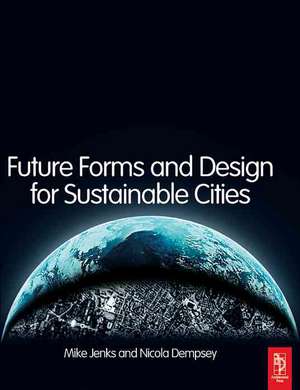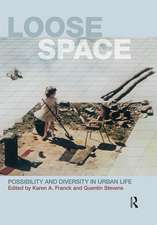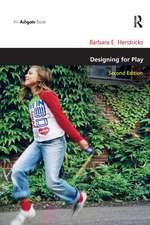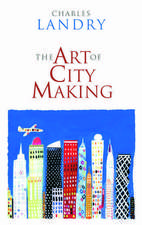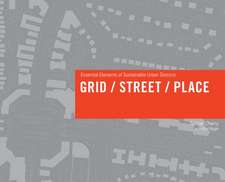Future Forms and Design For Sustainable Cities
Editat de Mike Jenks, Nicola Dempseyen Limba Engleză Paperback – 29 iul 2005
| Toate formatele și edițiile | Preț | Express |
|---|---|---|
| Paperback (1) | 268.66 lei 36-50 zile | |
| Taylor & Francis – 29 iul 2005 | 268.66 lei 36-50 zile | |
| Hardback (1) | 764.20 lei 43-57 zile | |
| Taylor & Francis – 31 mar 2016 | 764.20 lei 43-57 zile |
Preț: 268.66 lei
Preț vechi: 421.11 lei
-36% Nou
Puncte Express: 403
Preț estimativ în valută:
51.41€ • 53.81$ • 42.79£
51.41€ • 53.81$ • 42.79£
Carte tipărită la comandă
Livrare economică 24 martie-07 aprilie
Preluare comenzi: 021 569.72.76
Specificații
ISBN-13: 9780750663090
ISBN-10: 075066309X
Pagini: 460
Ilustrații: 1, black & white illustrations
Dimensiuni: 189 x 246 x 22 mm
Greutate: 0.85 kg
Ediția:1
Editura: Taylor & Francis
Colecția Routledge
Locul publicării:Oxford, United Kingdom
ISBN-10: 075066309X
Pagini: 460
Ilustrații: 1, black & white illustrations
Dimensiuni: 189 x 246 x 22 mm
Greutate: 0.85 kg
Ediția:1
Editura: Taylor & Francis
Colecția Routledge
Locul publicării:Oxford, United Kingdom
Public țintă
Professional Practice & DevelopmentCuprins
Introduction: Sustainable Urban Forms: Pointers to the Future? (Mike Jenks); Section One - The Big Picture: Cities and Regions; Introduction (Mike Jenks); Back to the City: A Route to Urban Sustainability (B. Giddings, B. Hopwood, M. Mellor and G. O'Brien); The Intelligent City: Ubiquitous Network or Humane Environment (N. Gillen and G. Briggs); Towards the Spatial Sustainability of City Regions (A. Okabe); Urban Planning and design: The Multi-modal Urban Region (L. Bertolini; Creating a Sustainable City Region (R. Green); A Land Consumption Model: Future Spatial Development (A. Frenkel); Forecasting the Sustainability of Alternative Plans (M. Echenique); Section Two - Designing for Sustainable Urban Form at High and Lower Densities: Introduction (Mike Jenks); High-density, High-rise and Multiple Intensive Land Use in Hong Kong: A Future City Form for the New Millennium (S. Lau); The City as Megastructure (J. Karakiewcz); From Central Business District to New Downtown: Revitalisation in Singapore (P. Yang); Towards a Sustainable City: Rebuilding Lower Manhattan (B. Willis); Roof City Transformations: A New Strategy (I. Hulshof); Sustainable Cells of Urbanism: A Regenerative Theory (T. Bartuska and B. Kazimee); Sustainable Urbanity in a Powerful but Fragile Landscape (F. Johns); Envisioning the Future: Sustainable Models for Rural Communities (H. Webster and P. Williams); Part Three - Aspects of Design for Sustainable Urban Forms: Introduction (Mike Jenks); The Language and Meaning of Density (M. Jenks and S. Green); Urban Densities and Accessibility to Local Facilities (K. Kaido); Emerging Work Patterns and their Place in Designing the City (N. Gillen); Solar Cities: The 'Solar Oxford' Initiative (S. Roaf, M. Fuentes and R. Gupta); Daylight for Urban Living: Solar Access Modelling for Public Spaces in Dense Urban Areas (J. Mardaljevic); High-density Housing Blocks: A Comparative Sustainability Assessment (A. Amato, R. Frewer and S. Humphrey); Conclusion: Future Forms for City living? (Mike Jenks)
Recenzii
"...Of particular interest to more advanced students of design ... an accessible presentation of the latest research in sustainable urban planning and design …”-- Icon
“...this very practical book is a reminder of how much remains to be done, [regarding design for sustainable cities] especially in North America ..." -- Azure
“...this very practical book is a reminder of how much remains to be done, [regarding design for sustainable cities] especially in North America ..." -- Azure
Descriere
Concentrating on the planning and design of cities, the three sections take a logical route through the discussion from the broad considerations at regional and city scale, to the larger city at high and lower densities through to design considerations on the smaller block scale. Key design issues such as access to facilities, access for sunlight, life cycle analyses, and the impact of communications on urban design are tackled, and in conclusion, the research is compared to large scale design examples that have been proposed and/or implemented over the past decade to give a vision for the future that might be achievable.
